HLTINF001 and HLTWHS002 - Infection Control, Prevention and Procedures
VerifiedAdded on 2023/04/11
|10
|2237
|391
Homework Assignment
AI Summary
This assignment solution addresses key aspects of infection control and prevention, focusing on policies, procedures, and practical applications in healthcare settings. It covers topics such as managing sick colleagues, understanding immunity, addressing infections like cellulitis, and implementing proper wound care techniques. The document also details the correct order for removing personal protective equipment, protocols for handling incidents like vomiting, and the importance of reporting obligations. Furthermore, it discusses duty of care, manual handling risks, and strategies for maintaining a healthy musculoskeletal system. The assignment concludes by emphasizing the significance of fire safety and risk minimization in both workplace and home environments. Desklib offers a wealth of similar resources and past papers to support students in their studies.
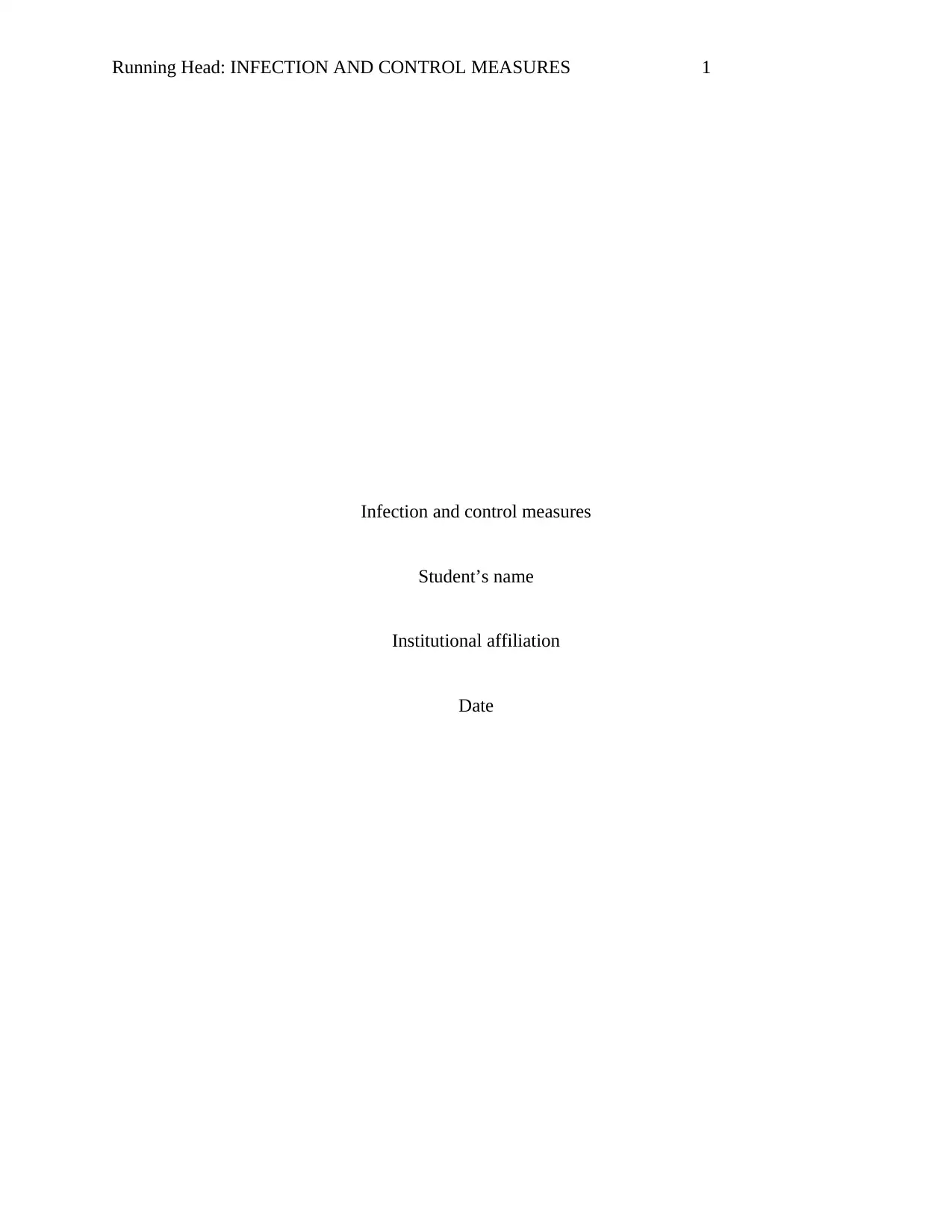
Running Head: INFECTION AND CONTROL MEASURES 1
Infection and control measures
Student’s name
Institutional affiliation
Date
Infection and control measures
Student’s name
Institutional affiliation
Date
Paraphrase This Document
Need a fresh take? Get an instant paraphrase of this document with our AI Paraphraser
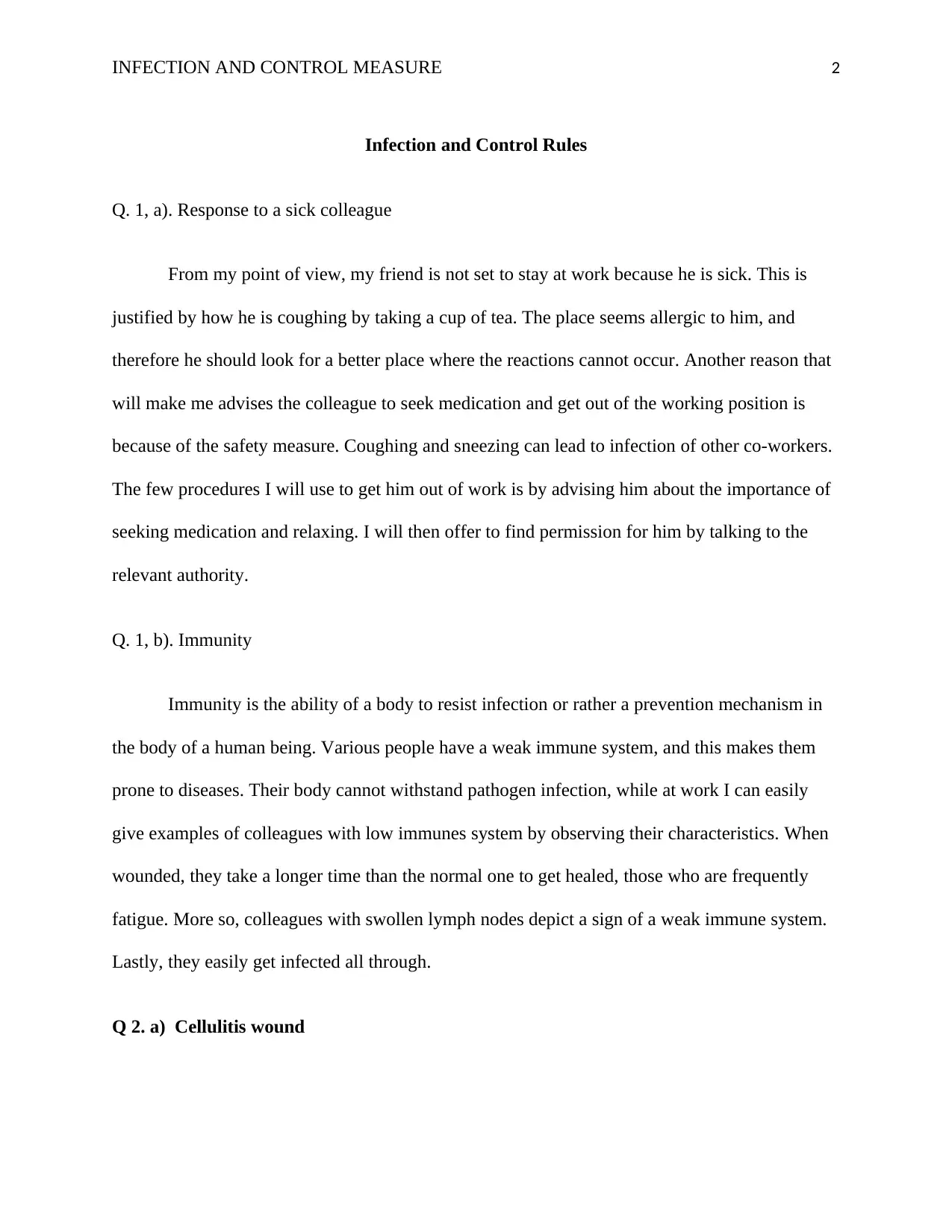
INFECTION AND CONTROL MEASURE 2
Infection and Control Rules
Q. 1, a). Response to a sick colleague
From my point of view, my friend is not set to stay at work because he is sick. This is
justified by how he is coughing by taking a cup of tea. The place seems allergic to him, and
therefore he should look for a better place where the reactions cannot occur. Another reason that
will make me advises the colleague to seek medication and get out of the working position is
because of the safety measure. Coughing and sneezing can lead to infection of other co-workers.
The few procedures I will use to get him out of work is by advising him about the importance of
seeking medication and relaxing. I will then offer to find permission for him by talking to the
relevant authority.
Q. 1, b). Immunity
Immunity is the ability of a body to resist infection or rather a prevention mechanism in
the body of a human being. Various people have a weak immune system, and this makes them
prone to diseases. Their body cannot withstand pathogen infection, while at work I can easily
give examples of colleagues with low immunes system by observing their characteristics. When
wounded, they take a longer time than the normal one to get healed, those who are frequently
fatigue. More so, colleagues with swollen lymph nodes depict a sign of a weak immune system.
Lastly, they easily get infected all through.
Q 2. a) Cellulitis wound
Infection and Control Rules
Q. 1, a). Response to a sick colleague
From my point of view, my friend is not set to stay at work because he is sick. This is
justified by how he is coughing by taking a cup of tea. The place seems allergic to him, and
therefore he should look for a better place where the reactions cannot occur. Another reason that
will make me advises the colleague to seek medication and get out of the working position is
because of the safety measure. Coughing and sneezing can lead to infection of other co-workers.
The few procedures I will use to get him out of work is by advising him about the importance of
seeking medication and relaxing. I will then offer to find permission for him by talking to the
relevant authority.
Q. 1, b). Immunity
Immunity is the ability of a body to resist infection or rather a prevention mechanism in
the body of a human being. Various people have a weak immune system, and this makes them
prone to diseases. Their body cannot withstand pathogen infection, while at work I can easily
give examples of colleagues with low immunes system by observing their characteristics. When
wounded, they take a longer time than the normal one to get healed, those who are frequently
fatigue. More so, colleagues with swollen lymph nodes depict a sign of a weak immune system.
Lastly, they easily get infected all through.
Q 2. a) Cellulitis wound
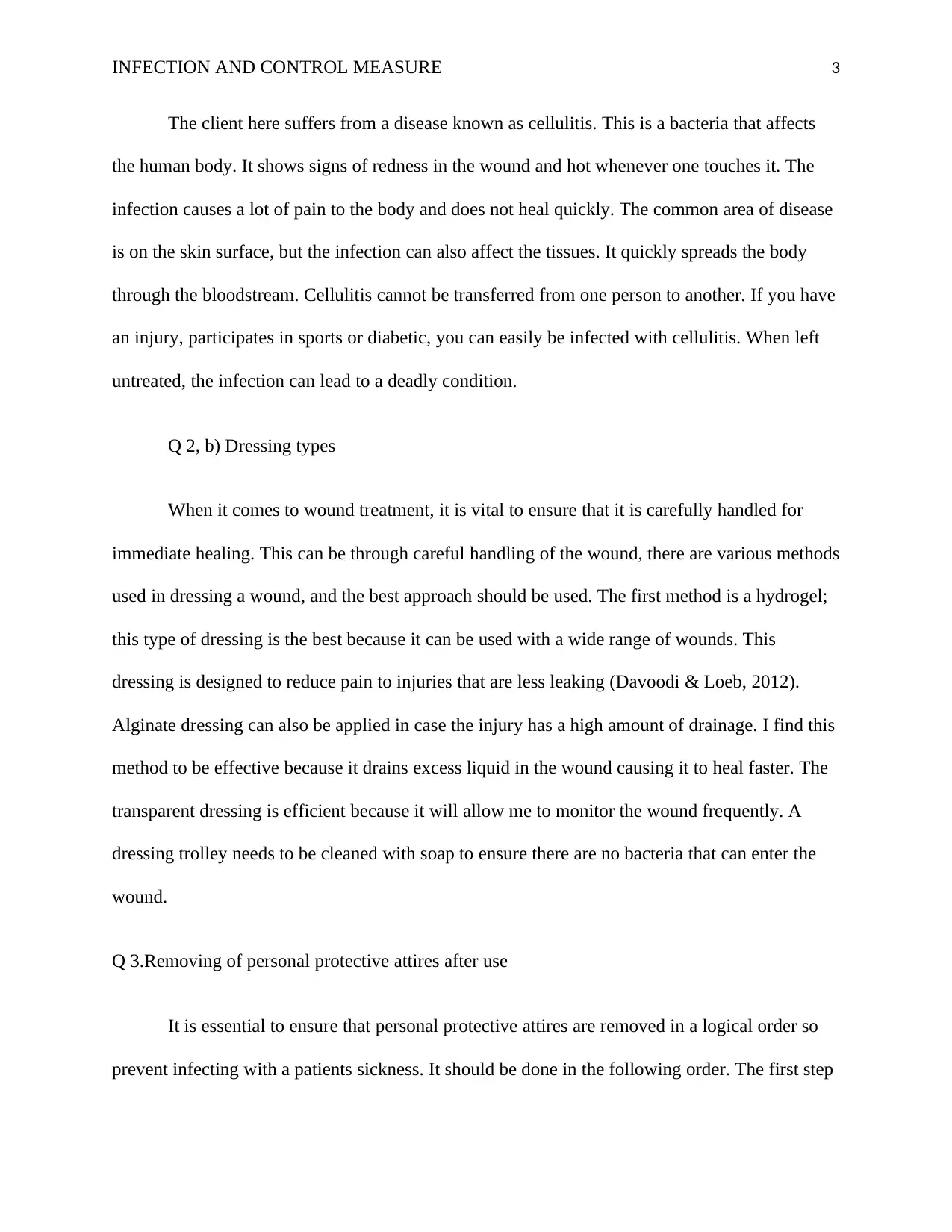
INFECTION AND CONTROL MEASURE 3
The client here suffers from a disease known as cellulitis. This is a bacteria that affects
the human body. It shows signs of redness in the wound and hot whenever one touches it. The
infection causes a lot of pain to the body and does not heal quickly. The common area of disease
is on the skin surface, but the infection can also affect the tissues. It quickly spreads the body
through the bloodstream. Cellulitis cannot be transferred from one person to another. If you have
an injury, participates in sports or diabetic, you can easily be infected with cellulitis. When left
untreated, the infection can lead to a deadly condition.
Q 2, b) Dressing types
When it comes to wound treatment, it is vital to ensure that it is carefully handled for
immediate healing. This can be through careful handling of the wound, there are various methods
used in dressing a wound, and the best approach should be used. The first method is a hydrogel;
this type of dressing is the best because it can be used with a wide range of wounds. This
dressing is designed to reduce pain to injuries that are less leaking (Davoodi & Loeb, 2012).
Alginate dressing can also be applied in case the injury has a high amount of drainage. I find this
method to be effective because it drains excess liquid in the wound causing it to heal faster. The
transparent dressing is efficient because it will allow me to monitor the wound frequently. A
dressing trolley needs to be cleaned with soap to ensure there are no bacteria that can enter the
wound.
Q 3.Removing of personal protective attires after use
It is essential to ensure that personal protective attires are removed in a logical order so
prevent infecting with a patients sickness. It should be done in the following order. The first step
The client here suffers from a disease known as cellulitis. This is a bacteria that affects
the human body. It shows signs of redness in the wound and hot whenever one touches it. The
infection causes a lot of pain to the body and does not heal quickly. The common area of disease
is on the skin surface, but the infection can also affect the tissues. It quickly spreads the body
through the bloodstream. Cellulitis cannot be transferred from one person to another. If you have
an injury, participates in sports or diabetic, you can easily be infected with cellulitis. When left
untreated, the infection can lead to a deadly condition.
Q 2, b) Dressing types
When it comes to wound treatment, it is vital to ensure that it is carefully handled for
immediate healing. This can be through careful handling of the wound, there are various methods
used in dressing a wound, and the best approach should be used. The first method is a hydrogel;
this type of dressing is the best because it can be used with a wide range of wounds. This
dressing is designed to reduce pain to injuries that are less leaking (Davoodi & Loeb, 2012).
Alginate dressing can also be applied in case the injury has a high amount of drainage. I find this
method to be effective because it drains excess liquid in the wound causing it to heal faster. The
transparent dressing is efficient because it will allow me to monitor the wound frequently. A
dressing trolley needs to be cleaned with soap to ensure there are no bacteria that can enter the
wound.
Q 3.Removing of personal protective attires after use
It is essential to ensure that personal protective attires are removed in a logical order so
prevent infecting with a patients sickness. It should be done in the following order. The first step
⊘ This is a preview!⊘
Do you want full access?
Subscribe today to unlock all pages.

Trusted by 1+ million students worldwide
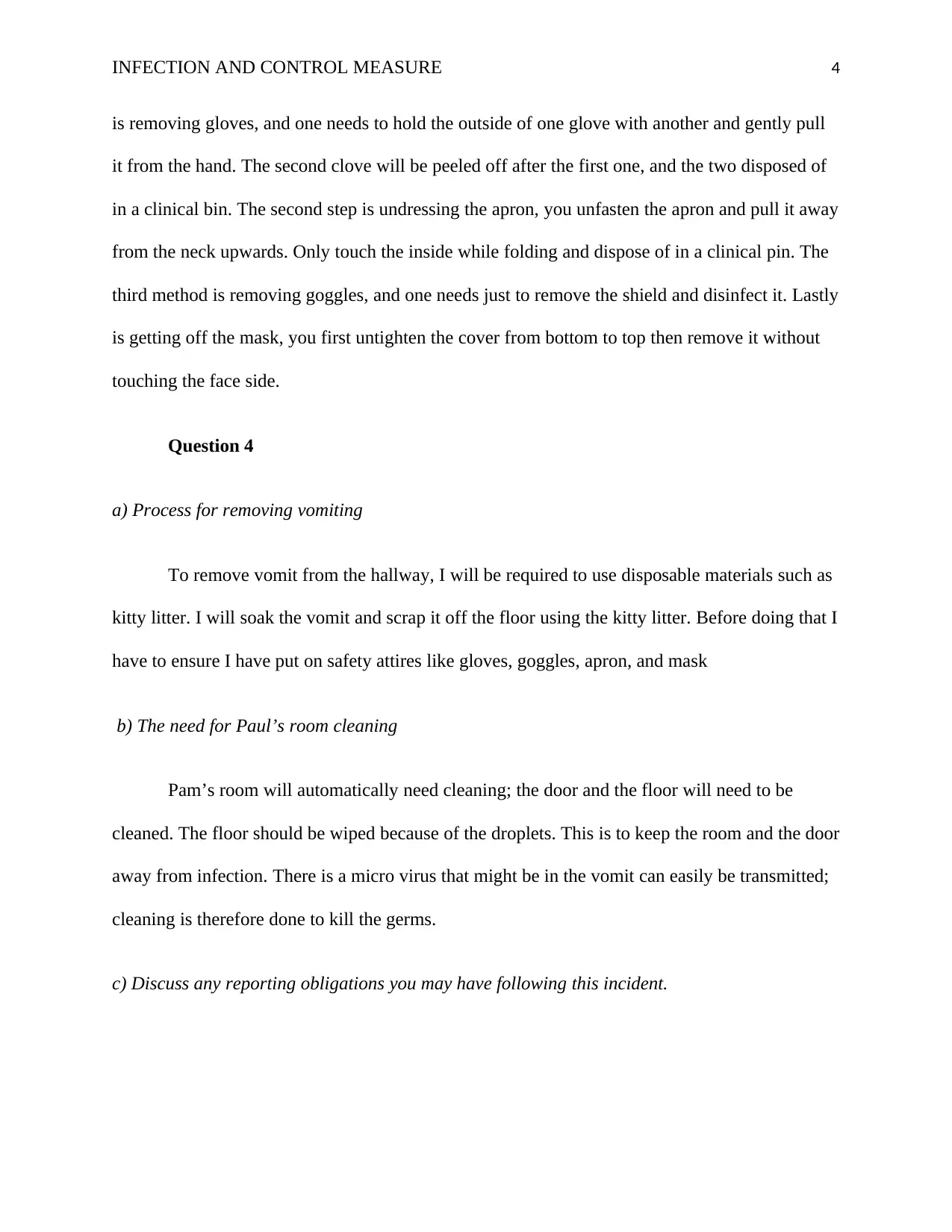
INFECTION AND CONTROL MEASURE 4
is removing gloves, and one needs to hold the outside of one glove with another and gently pull
it from the hand. The second clove will be peeled off after the first one, and the two disposed of
in a clinical bin. The second step is undressing the apron, you unfasten the apron and pull it away
from the neck upwards. Only touch the inside while folding and dispose of in a clinical pin. The
third method is removing goggles, and one needs just to remove the shield and disinfect it. Lastly
is getting off the mask, you first untighten the cover from bottom to top then remove it without
touching the face side.
Question 4
a) Process for removing vomiting
To remove vomit from the hallway, I will be required to use disposable materials such as
kitty litter. I will soak the vomit and scrap it off the floor using the kitty litter. Before doing that I
have to ensure I have put on safety attires like gloves, goggles, apron, and mask
b) The need for Paul’s room cleaning
Pam’s room will automatically need cleaning; the door and the floor will need to be
cleaned. The floor should be wiped because of the droplets. This is to keep the room and the door
away from infection. There is a micro virus that might be in the vomit can easily be transmitted;
cleaning is therefore done to kill the germs.
c) Discuss any reporting obligations you may have following this incident.
is removing gloves, and one needs to hold the outside of one glove with another and gently pull
it from the hand. The second clove will be peeled off after the first one, and the two disposed of
in a clinical bin. The second step is undressing the apron, you unfasten the apron and pull it away
from the neck upwards. Only touch the inside while folding and dispose of in a clinical pin. The
third method is removing goggles, and one needs just to remove the shield and disinfect it. Lastly
is getting off the mask, you first untighten the cover from bottom to top then remove it without
touching the face side.
Question 4
a) Process for removing vomiting
To remove vomit from the hallway, I will be required to use disposable materials such as
kitty litter. I will soak the vomit and scrap it off the floor using the kitty litter. Before doing that I
have to ensure I have put on safety attires like gloves, goggles, apron, and mask
b) The need for Paul’s room cleaning
Pam’s room will automatically need cleaning; the door and the floor will need to be
cleaned. The floor should be wiped because of the droplets. This is to keep the room and the door
away from infection. There is a micro virus that might be in the vomit can easily be transmitted;
cleaning is therefore done to kill the germs.
c) Discuss any reporting obligations you may have following this incident.
Paraphrase This Document
Need a fresh take? Get an instant paraphrase of this document with our AI Paraphraser
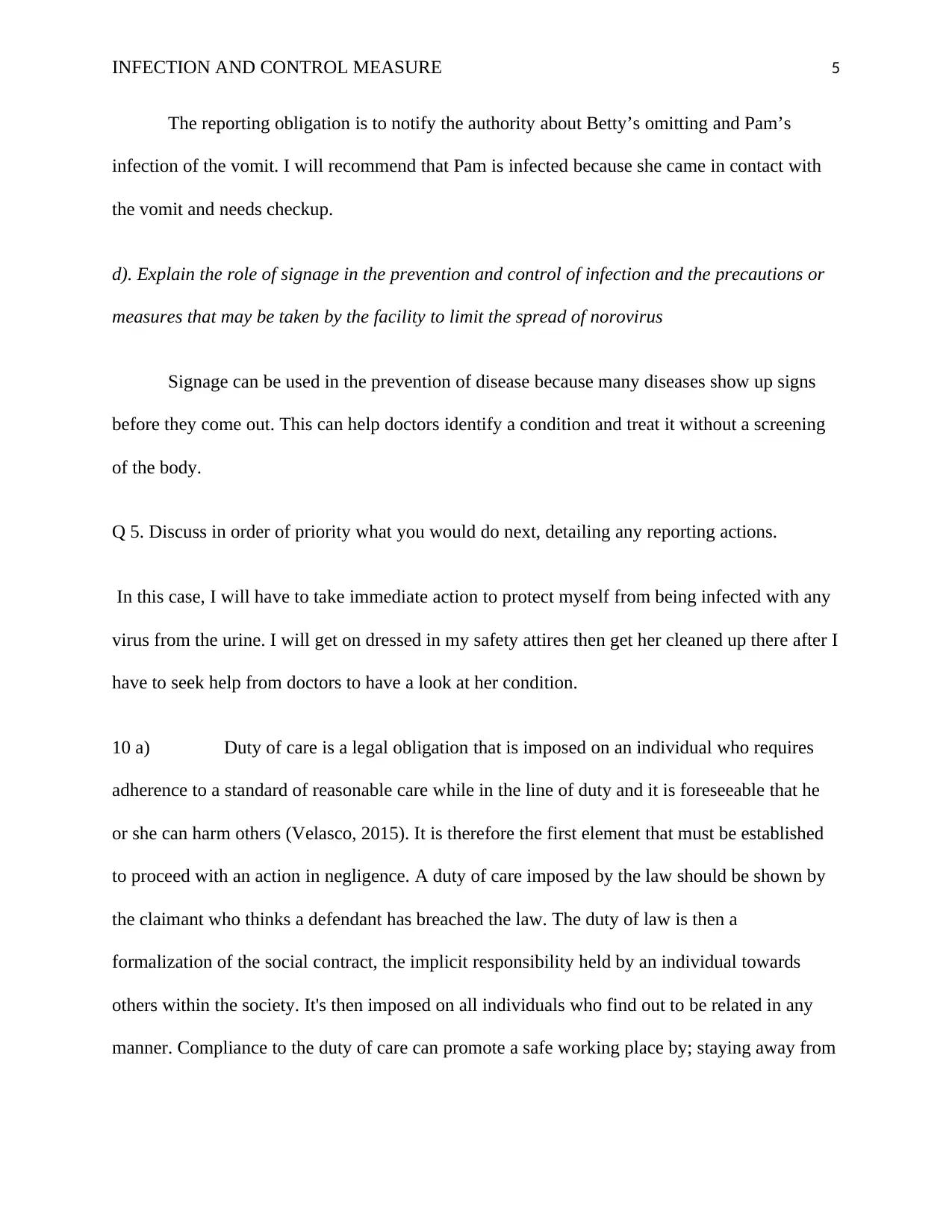
INFECTION AND CONTROL MEASURE 5
The reporting obligation is to notify the authority about Betty’s omitting and Pam’s
infection of the vomit. I will recommend that Pam is infected because she came in contact with
the vomit and needs checkup.
d). Explain the role of signage in the prevention and control of infection and the precautions or
measures that may be taken by the facility to limit the spread of norovirus
Signage can be used in the prevention of disease because many diseases show up signs
before they come out. This can help doctors identify a condition and treat it without a screening
of the body.
Q 5. Discuss in order of priority what you would do next, detailing any reporting actions.
In this case, I will have to take immediate action to protect myself from being infected with any
virus from the urine. I will get on dressed in my safety attires then get her cleaned up there after I
have to seek help from doctors to have a look at her condition.
10 a) Duty of care is a legal obligation that is imposed on an individual who requires
adherence to a standard of reasonable care while in the line of duty and it is foreseeable that he
or she can harm others (Velasco, 2015). It is therefore the first element that must be established
to proceed with an action in negligence. A duty of care imposed by the law should be shown by
the claimant who thinks a defendant has breached the law. The duty of law is then a
formalization of the social contract, the implicit responsibility held by an individual towards
others within the society. It's then imposed on all individuals who find out to be related in any
manner. Compliance to the duty of care can promote a safe working place by; staying away from
The reporting obligation is to notify the authority about Betty’s omitting and Pam’s
infection of the vomit. I will recommend that Pam is infected because she came in contact with
the vomit and needs checkup.
d). Explain the role of signage in the prevention and control of infection and the precautions or
measures that may be taken by the facility to limit the spread of norovirus
Signage can be used in the prevention of disease because many diseases show up signs
before they come out. This can help doctors identify a condition and treat it without a screening
of the body.
Q 5. Discuss in order of priority what you would do next, detailing any reporting actions.
In this case, I will have to take immediate action to protect myself from being infected with any
virus from the urine. I will get on dressed in my safety attires then get her cleaned up there after I
have to seek help from doctors to have a look at her condition.
10 a) Duty of care is a legal obligation that is imposed on an individual who requires
adherence to a standard of reasonable care while in the line of duty and it is foreseeable that he
or she can harm others (Velasco, 2015). It is therefore the first element that must be established
to proceed with an action in negligence. A duty of care imposed by the law should be shown by
the claimant who thinks a defendant has breached the law. The duty of law is then a
formalization of the social contract, the implicit responsibility held by an individual towards
others within the society. It's then imposed on all individuals who find out to be related in any
manner. Compliance to the duty of care can promote a safe working place by; staying away from
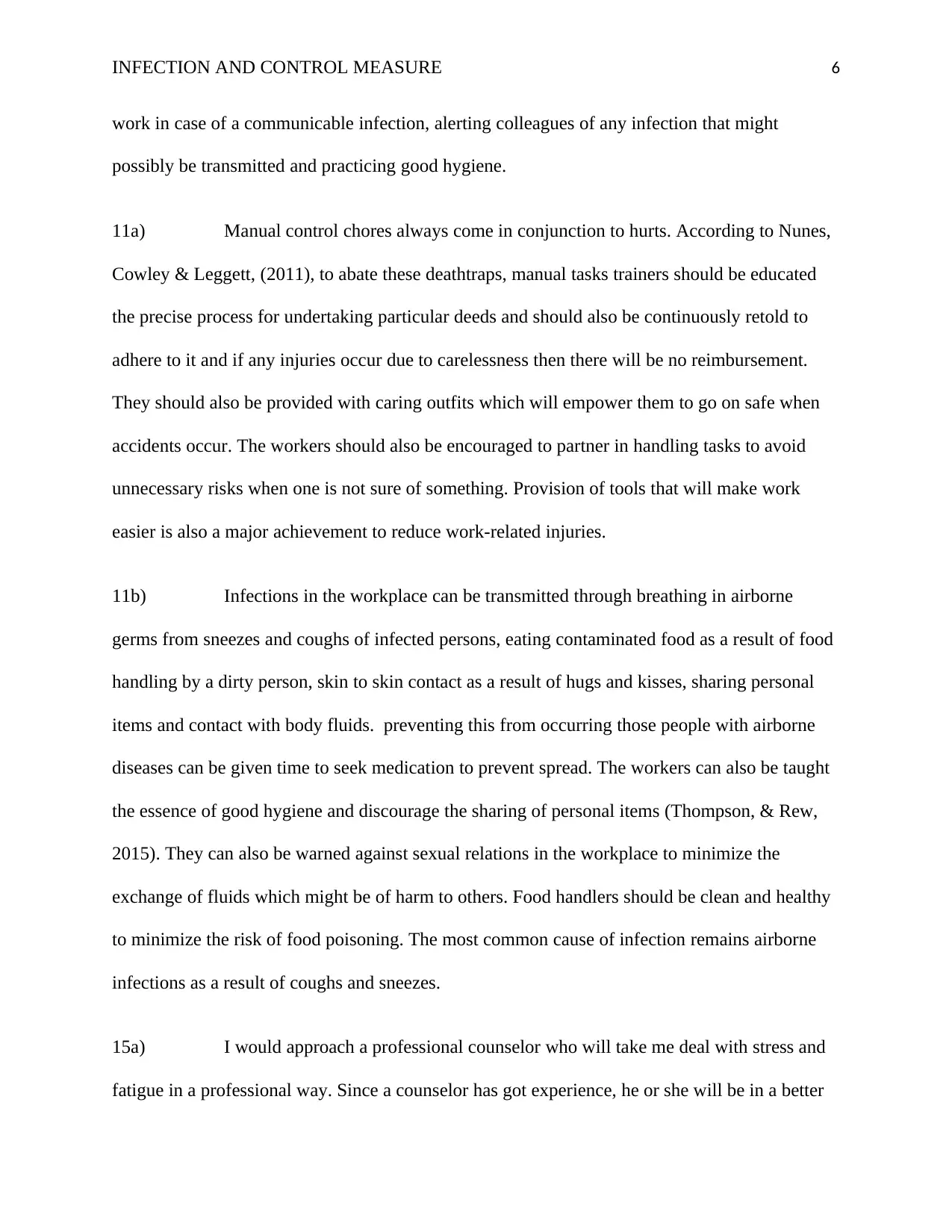
INFECTION AND CONTROL MEASURE 6
work in case of a communicable infection, alerting colleagues of any infection that might
possibly be transmitted and practicing good hygiene.
11a) Manual control chores always come in conjunction to hurts. According to Nunes,
Cowley & Leggett, (2011), to abate these deathtraps, manual tasks trainers should be educated
the precise process for undertaking particular deeds and should also be continuously retold to
adhere to it and if any injuries occur due to carelessness then there will be no reimbursement.
They should also be provided with caring outfits which will empower them to go on safe when
accidents occur. The workers should also be encouraged to partner in handling tasks to avoid
unnecessary risks when one is not sure of something. Provision of tools that will make work
easier is also a major achievement to reduce work-related injuries.
11b) Infections in the workplace can be transmitted through breathing in airborne
germs from sneezes and coughs of infected persons, eating contaminated food as a result of food
handling by a dirty person, skin to skin contact as a result of hugs and kisses, sharing personal
items and contact with body fluids. preventing this from occurring those people with airborne
diseases can be given time to seek medication to prevent spread. The workers can also be taught
the essence of good hygiene and discourage the sharing of personal items (Thompson, & Rew,
2015). They can also be warned against sexual relations in the workplace to minimize the
exchange of fluids which might be of harm to others. Food handlers should be clean and healthy
to minimize the risk of food poisoning. The most common cause of infection remains airborne
infections as a result of coughs and sneezes.
15a) I would approach a professional counselor who will take me deal with stress and
fatigue in a professional way. Since a counselor has got experience, he or she will be in a better
work in case of a communicable infection, alerting colleagues of any infection that might
possibly be transmitted and practicing good hygiene.
11a) Manual control chores always come in conjunction to hurts. According to Nunes,
Cowley & Leggett, (2011), to abate these deathtraps, manual tasks trainers should be educated
the precise process for undertaking particular deeds and should also be continuously retold to
adhere to it and if any injuries occur due to carelessness then there will be no reimbursement.
They should also be provided with caring outfits which will empower them to go on safe when
accidents occur. The workers should also be encouraged to partner in handling tasks to avoid
unnecessary risks when one is not sure of something. Provision of tools that will make work
easier is also a major achievement to reduce work-related injuries.
11b) Infections in the workplace can be transmitted through breathing in airborne
germs from sneezes and coughs of infected persons, eating contaminated food as a result of food
handling by a dirty person, skin to skin contact as a result of hugs and kisses, sharing personal
items and contact with body fluids. preventing this from occurring those people with airborne
diseases can be given time to seek medication to prevent spread. The workers can also be taught
the essence of good hygiene and discourage the sharing of personal items (Thompson, & Rew,
2015). They can also be warned against sexual relations in the workplace to minimize the
exchange of fluids which might be of harm to others. Food handlers should be clean and healthy
to minimize the risk of food poisoning. The most common cause of infection remains airborne
infections as a result of coughs and sneezes.
15a) I would approach a professional counselor who will take me deal with stress and
fatigue in a professional way. Since a counselor has got experience, he or she will be in a better
⊘ This is a preview!⊘
Do you want full access?
Subscribe today to unlock all pages.

Trusted by 1+ million students worldwide
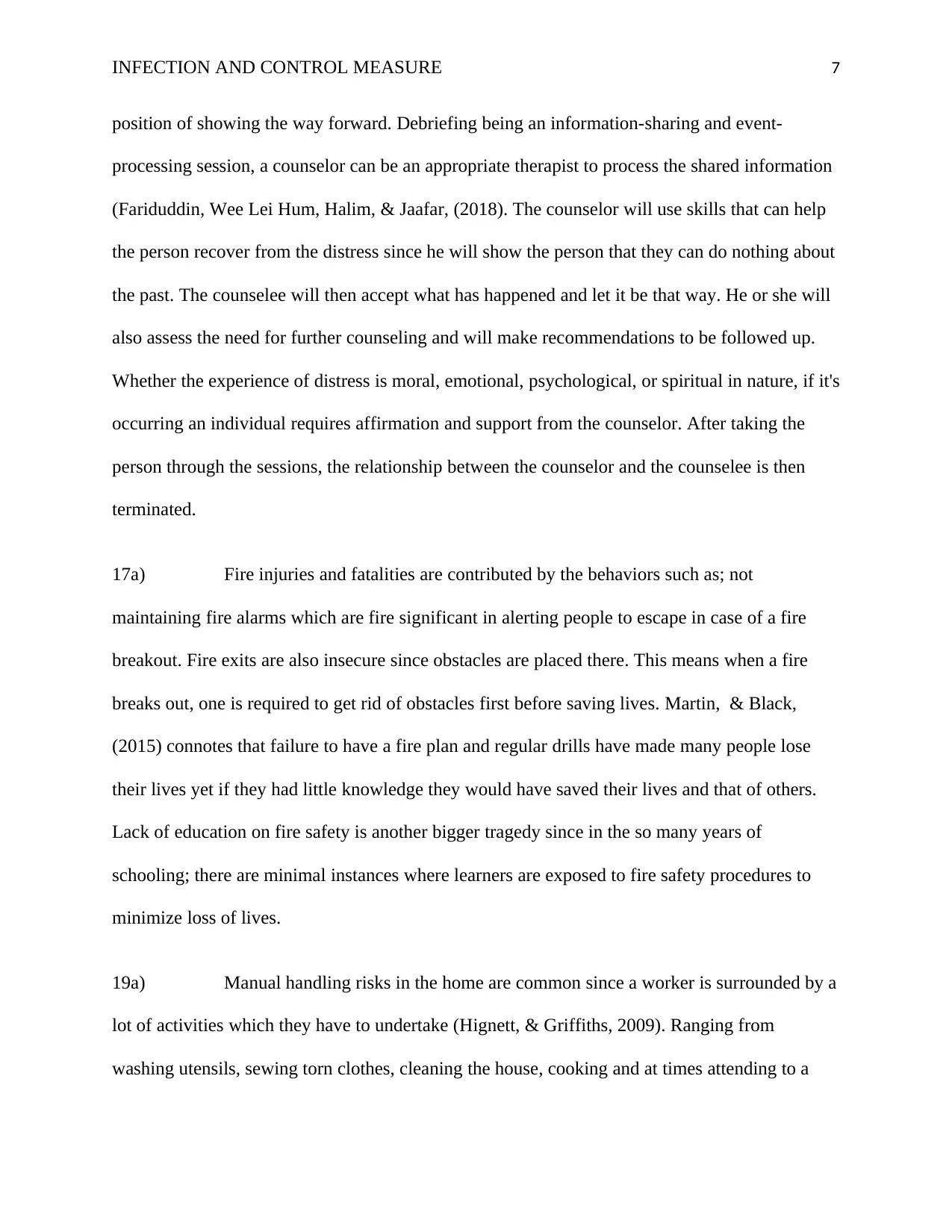
INFECTION AND CONTROL MEASURE 7
position of showing the way forward. Debriefing being an information-sharing and event-
processing session, a counselor can be an appropriate therapist to process the shared information
(Fariduddin, Wee Lei Hum, Halim, & Jaafar, (2018). The counselor will use skills that can help
the person recover from the distress since he will show the person that they can do nothing about
the past. The counselee will then accept what has happened and let it be that way. He or she will
also assess the need for further counseling and will make recommendations to be followed up.
Whether the experience of distress is moral, emotional, psychological, or spiritual in nature, if it's
occurring an individual requires affirmation and support from the counselor. After taking the
person through the sessions, the relationship between the counselor and the counselee is then
terminated.
17a) Fire injuries and fatalities are contributed by the behaviors such as; not
maintaining fire alarms which are fire significant in alerting people to escape in case of a fire
breakout. Fire exits are also insecure since obstacles are placed there. This means when a fire
breaks out, one is required to get rid of obstacles first before saving lives. Martin, & Black,
(2015) connotes that failure to have a fire plan and regular drills have made many people lose
their lives yet if they had little knowledge they would have saved their lives and that of others.
Lack of education on fire safety is another bigger tragedy since in the so many years of
schooling; there are minimal instances where learners are exposed to fire safety procedures to
minimize loss of lives.
19a) Manual handling risks in the home are common since a worker is surrounded by a
lot of activities which they have to undertake (Hignett, & Griffiths, 2009). Ranging from
washing utensils, sewing torn clothes, cleaning the house, cooking and at times attending to a
position of showing the way forward. Debriefing being an information-sharing and event-
processing session, a counselor can be an appropriate therapist to process the shared information
(Fariduddin, Wee Lei Hum, Halim, & Jaafar, (2018). The counselor will use skills that can help
the person recover from the distress since he will show the person that they can do nothing about
the past. The counselee will then accept what has happened and let it be that way. He or she will
also assess the need for further counseling and will make recommendations to be followed up.
Whether the experience of distress is moral, emotional, psychological, or spiritual in nature, if it's
occurring an individual requires affirmation and support from the counselor. After taking the
person through the sessions, the relationship between the counselor and the counselee is then
terminated.
17a) Fire injuries and fatalities are contributed by the behaviors such as; not
maintaining fire alarms which are fire significant in alerting people to escape in case of a fire
breakout. Fire exits are also insecure since obstacles are placed there. This means when a fire
breaks out, one is required to get rid of obstacles first before saving lives. Martin, & Black,
(2015) connotes that failure to have a fire plan and regular drills have made many people lose
their lives yet if they had little knowledge they would have saved their lives and that of others.
Lack of education on fire safety is another bigger tragedy since in the so many years of
schooling; there are minimal instances where learners are exposed to fire safety procedures to
minimize loss of lives.
19a) Manual handling risks in the home are common since a worker is surrounded by a
lot of activities which they have to undertake (Hignett, & Griffiths, 2009). Ranging from
washing utensils, sewing torn clothes, cleaning the house, cooking and at times attending to a
Paraphrase This Document
Need a fresh take? Get an instant paraphrase of this document with our AI Paraphraser
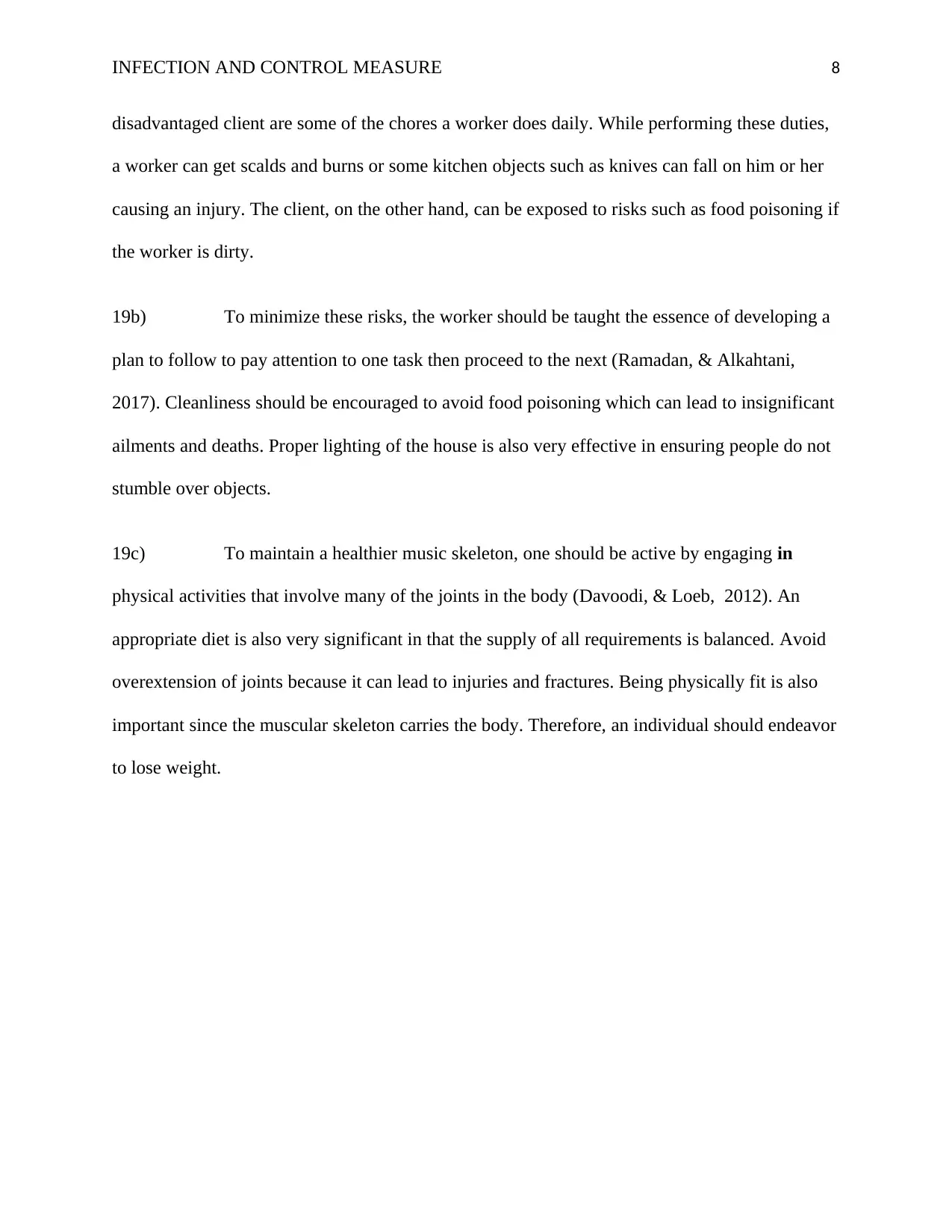
INFECTION AND CONTROL MEASURE 8
disadvantaged client are some of the chores a worker does daily. While performing these duties,
a worker can get scalds and burns or some kitchen objects such as knives can fall on him or her
causing an injury. The client, on the other hand, can be exposed to risks such as food poisoning if
the worker is dirty.
19b) To minimize these risks, the worker should be taught the essence of developing a
plan to follow to pay attention to one task then proceed to the next (Ramadan, & Alkahtani,
2017). Cleanliness should be encouraged to avoid food poisoning which can lead to insignificant
ailments and deaths. Proper lighting of the house is also very effective in ensuring people do not
stumble over objects.
19c) To maintain a healthier music skeleton, one should be active by engaging in
physical activities that involve many of the joints in the body (Davoodi, & Loeb, 2012). An
appropriate diet is also very significant in that the supply of all requirements is balanced. Avoid
overextension of joints because it can lead to injuries and fractures. Being physically fit is also
important since the muscular skeleton carries the body. Therefore, an individual should endeavor
to lose weight.
disadvantaged client are some of the chores a worker does daily. While performing these duties,
a worker can get scalds and burns or some kitchen objects such as knives can fall on him or her
causing an injury. The client, on the other hand, can be exposed to risks such as food poisoning if
the worker is dirty.
19b) To minimize these risks, the worker should be taught the essence of developing a
plan to follow to pay attention to one task then proceed to the next (Ramadan, & Alkahtani,
2017). Cleanliness should be encouraged to avoid food poisoning which can lead to insignificant
ailments and deaths. Proper lighting of the house is also very effective in ensuring people do not
stumble over objects.
19c) To maintain a healthier music skeleton, one should be active by engaging in
physical activities that involve many of the joints in the body (Davoodi, & Loeb, 2012). An
appropriate diet is also very significant in that the supply of all requirements is balanced. Avoid
overextension of joints because it can lead to injuries and fractures. Being physically fit is also
important since the muscular skeleton carries the body. Therefore, an individual should endeavor
to lose weight.
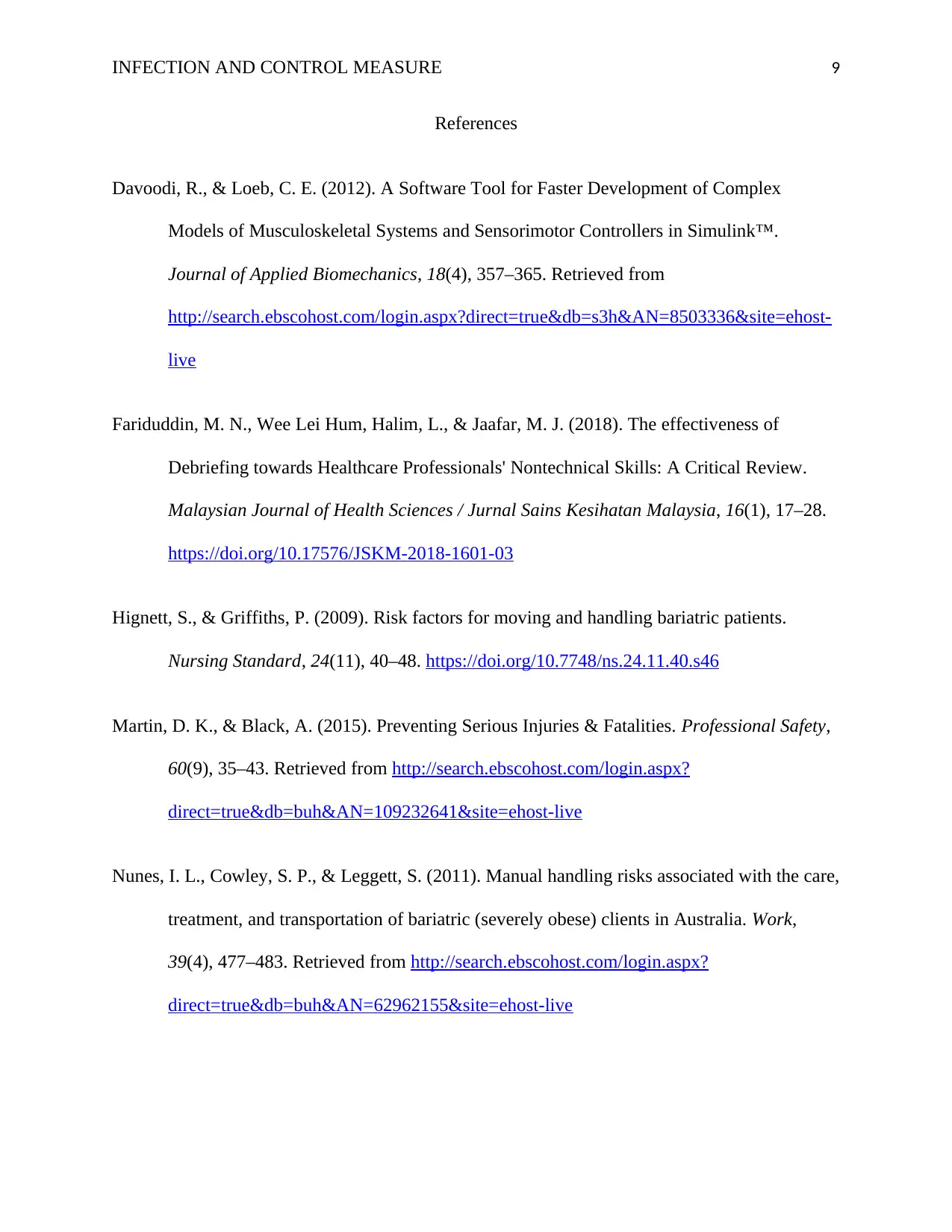
INFECTION AND CONTROL MEASURE 9
References
Davoodi, R., & Loeb, C. E. (2012). A Software Tool for Faster Development of Complex
Models of Musculoskeletal Systems and Sensorimotor Controllers in Simulink™.
Journal of Applied Biomechanics, 18(4), 357–365. Retrieved from
http://search.ebscohost.com/login.aspx?direct=true&db=s3h&AN=8503336&site=ehost-
live
Fariduddin, M. N., Wee Lei Hum, Halim, L., & Jaafar, M. J. (2018). The effectiveness of
Debriefing towards Healthcare Professionals' Nontechnical Skills: A Critical Review.
Malaysian Journal of Health Sciences / Jurnal Sains Kesihatan Malaysia, 16(1), 17–28.
https://doi.org/10.17576/JSKM-2018-1601-03
Hignett, S., & Griffiths, P. (2009). Risk factors for moving and handling bariatric patients.
Nursing Standard, 24(11), 40–48. https://doi.org/10.7748/ns.24.11.40.s46
Martin, D. K., & Black, A. (2015). Preventing Serious Injuries & Fatalities. Professional Safety,
60(9), 35–43. Retrieved from http://search.ebscohost.com/login.aspx?
direct=true&db=buh&AN=109232641&site=ehost-live
Nunes, I. L., Cowley, S. P., & Leggett, S. (2011). Manual handling risks associated with the care,
treatment, and transportation of bariatric (severely obese) clients in Australia. Work,
39(4), 477–483. Retrieved from http://search.ebscohost.com/login.aspx?
direct=true&db=buh&AN=62962155&site=ehost-live
References
Davoodi, R., & Loeb, C. E. (2012). A Software Tool for Faster Development of Complex
Models of Musculoskeletal Systems and Sensorimotor Controllers in Simulink™.
Journal of Applied Biomechanics, 18(4), 357–365. Retrieved from
http://search.ebscohost.com/login.aspx?direct=true&db=s3h&AN=8503336&site=ehost-
live
Fariduddin, M. N., Wee Lei Hum, Halim, L., & Jaafar, M. J. (2018). The effectiveness of
Debriefing towards Healthcare Professionals' Nontechnical Skills: A Critical Review.
Malaysian Journal of Health Sciences / Jurnal Sains Kesihatan Malaysia, 16(1), 17–28.
https://doi.org/10.17576/JSKM-2018-1601-03
Hignett, S., & Griffiths, P. (2009). Risk factors for moving and handling bariatric patients.
Nursing Standard, 24(11), 40–48. https://doi.org/10.7748/ns.24.11.40.s46
Martin, D. K., & Black, A. (2015). Preventing Serious Injuries & Fatalities. Professional Safety,
60(9), 35–43. Retrieved from http://search.ebscohost.com/login.aspx?
direct=true&db=buh&AN=109232641&site=ehost-live
Nunes, I. L., Cowley, S. P., & Leggett, S. (2011). Manual handling risks associated with the care,
treatment, and transportation of bariatric (severely obese) clients in Australia. Work,
39(4), 477–483. Retrieved from http://search.ebscohost.com/login.aspx?
direct=true&db=buh&AN=62962155&site=ehost-live
⊘ This is a preview!⊘
Do you want full access?
Subscribe today to unlock all pages.

Trusted by 1+ million students worldwide
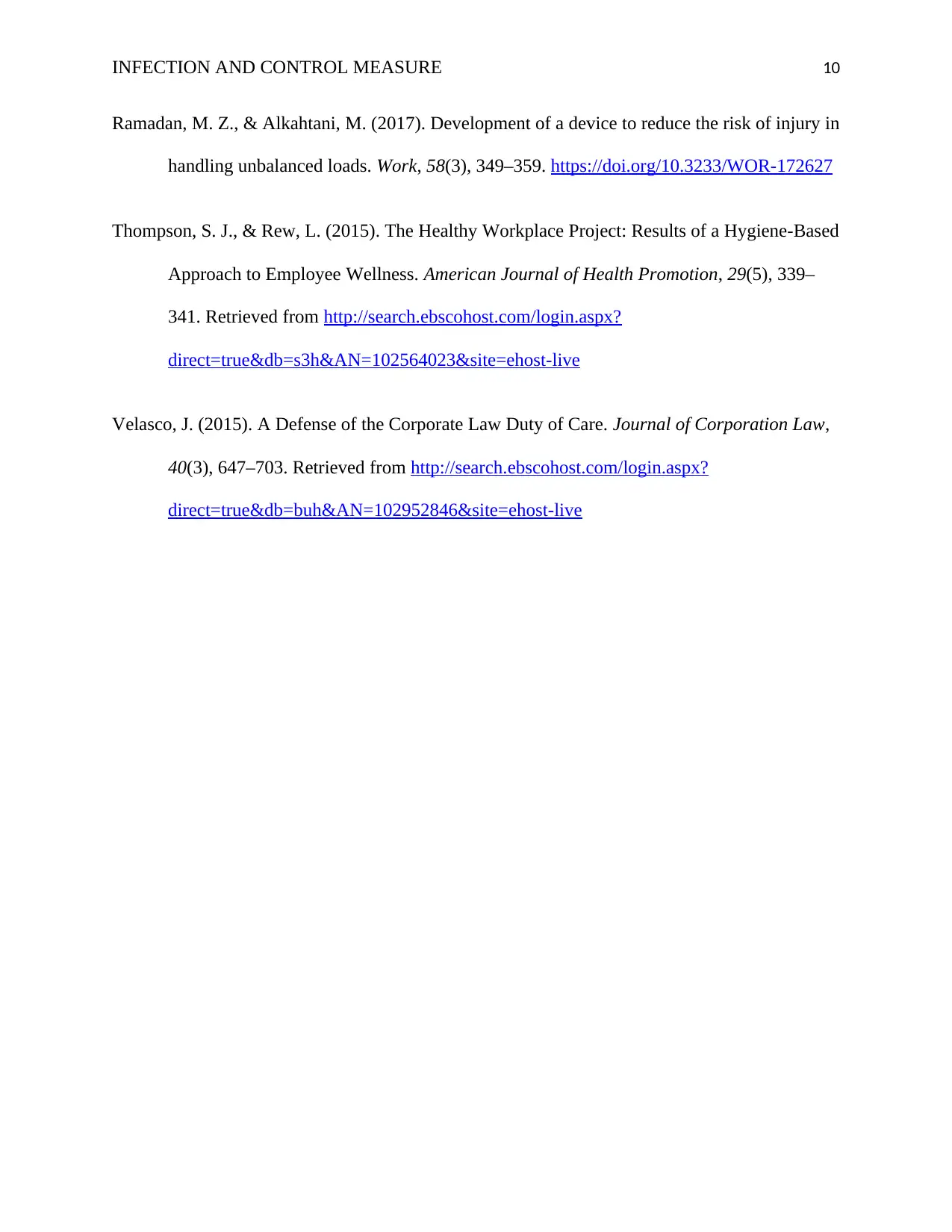
INFECTION AND CONTROL MEASURE 10
Ramadan, M. Z., & Alkahtani, M. (2017). Development of a device to reduce the risk of injury in
handling unbalanced loads. Work, 58(3), 349–359. https://doi.org/10.3233/WOR-172627
Thompson, S. J., & Rew, L. (2015). The Healthy Workplace Project: Results of a Hygiene-Based
Approach to Employee Wellness. American Journal of Health Promotion, 29(5), 339–
341. Retrieved from http://search.ebscohost.com/login.aspx?
direct=true&db=s3h&AN=102564023&site=ehost-live
Velasco, J. (2015). A Defense of the Corporate Law Duty of Care. Journal of Corporation Law,
40(3), 647–703. Retrieved from http://search.ebscohost.com/login.aspx?
direct=true&db=buh&AN=102952846&site=ehost-live
Ramadan, M. Z., & Alkahtani, M. (2017). Development of a device to reduce the risk of injury in
handling unbalanced loads. Work, 58(3), 349–359. https://doi.org/10.3233/WOR-172627
Thompson, S. J., & Rew, L. (2015). The Healthy Workplace Project: Results of a Hygiene-Based
Approach to Employee Wellness. American Journal of Health Promotion, 29(5), 339–
341. Retrieved from http://search.ebscohost.com/login.aspx?
direct=true&db=s3h&AN=102564023&site=ehost-live
Velasco, J. (2015). A Defense of the Corporate Law Duty of Care. Journal of Corporation Law,
40(3), 647–703. Retrieved from http://search.ebscohost.com/login.aspx?
direct=true&db=buh&AN=102952846&site=ehost-live
1 out of 10
Related Documents
Your All-in-One AI-Powered Toolkit for Academic Success.
+13062052269
info@desklib.com
Available 24*7 on WhatsApp / Email
![[object Object]](/_next/static/media/star-bottom.7253800d.svg)
Unlock your academic potential
Copyright © 2020–2025 A2Z Services. All Rights Reserved. Developed and managed by ZUCOL.





